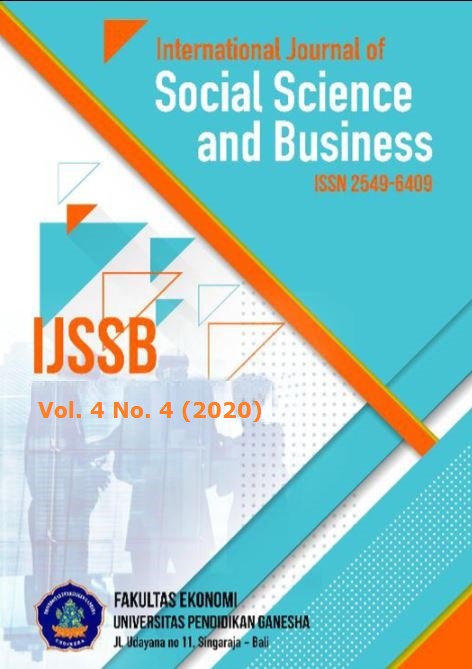Face to Face Sales and Sales Promotions have a Positive Effect on Gold Jewelry Purchasing Decisions
DOI:
https://doi.org/10.23887/ijssb.v4i4.28630Keywords:
Face to Face Sales, Sales Promotion, Purchasing DecisionsAbstract
Purchasing decisions are influenced by various factors, both internal and external factors. Face-to-face selling and sales promotion are two factors that can influence purchasing decisions. This study aims to analyze the influence of face-to-face sales and sales promotions on purchasing decisions for gold jewelry. This research is a a quantitative approach research. The population used in this study amounted to 1,193 consumers. The sampling method used was accidental sampling, in order to obtain a sample of 92 people. The data were collected using interview techniques and questionnaires. The collected data were analyzed using multiple linear regression analysis techniques using SPSS version 22 statistical tools. The results showed that face-to-face sales and sales promotion variables together had a positive effect on purchasing decisions. This can be proven from the results of F-count (195.569) higher than F-table (3.10) with a significance level of 0.000 less than 0.05, then Ha is accepted and H0 is rejected. It can be concluded that in simultaneously, there is a significant and positive influence between face-to-face sales and sales promotion on gold jewelry purchasing decisions.
References
Abdurrahman, S. (2015). Manajemen Strategi Pemasaran. CV. Pustaka Setia.
Anderson, J. C., Thomson, B. ., & Wynstra, F. (2000). Combining value and price to make purchase decisions in business markets. International Journal of Research in Marketing, 17(4), 307–329. https://doi.org/10.1016/S0167-8116(00)00029-X
Carlos Alberto, G., Myriam, M.-F., I.Viedma-del-Jesús, M., & Aranda, L. A. (2020). The processing of price during purchase decision making: Are there neural differences among prosocial and non-prosocial consumers? Journal of Cleaner Production, 271, 26–48. https://doi.org/10.1016/j.jclepro.2020.122648
Chang Li, S. (2013). Exploring the Relationships among Service Quality, Customer Loyalty and Word-Of-Mouth for Private Higher Education in Taiwan. Asia Pacific Management Review, 18(4), 375–389. https://doi.org/10.6126/APMR.2013.18.4.02
Hermawan, A. (2013). Komunikasi Pemasaran. Erlangga.
Kotler, & Amstrong. (2015). Marketing an Introducing Prentice Hall twelfht edition. Pearson Education.
Kotler, & Keller. (2012). Manajemen Pemasaran (12th ed.). Erlangga.
Kotler, Philip, & Amstrong, G. (2014). Principles of Marketing (Bob Sabran (ed.)). Erlangga.
Kukar-Kinney, M., M.Ridgwaya, N., & B.Monroe, K. (2012). The Role of Price in the Behavior and Purchase Decisions of Compulsive Buyers. Journal of Retailing, 88(1), 63–71. https://doi.org/10.1016/j.jretai.2011.02.004
Machfoedz, M. (2013). Pengantar Pemasaran Modern. Akademi Manajemen Pemasaran YPKPN.
Margaretha, F. (2012). Analisa Pengaruh Food Quality dan Brand Image Terhadap Keputusan Pembelian Roti Kecil Toko Roti Ganep’s di Kota Solo. Jurnal Manajemen Pemasaran, 1(1), 1–6.
Petricia, D., & Syahputra. (2015). Pengaruh Kualitas Produk, Harga, Promosi dan Kualitas Pelayanan terhadap Proses Keputusan Pembelian (Studi pada Konsumen Kopi Progo Bandung). Eproceeding of Management, 2(2), 2117–2124.
Robot, & Mariska, J. (2015). Analisis Pengaruh Adsvertising, Personal Selling, Sales Promotion, Publicity dan Wordof Mouth Terhadap Keputusan Pembelian. Skripsi.Universitas Sam Ratulangi.
Rustam, T. A. (2019). Pengaruh Kualitas Produk, Citra Merk dan Promosi terhadap Keputusan Pembelian Spare part pada Bengkel Aneka Motor Kabupatan Padang Pariaman. Owner (Riset Dan Jurnal Akuntansi), 3(2), 320–328. https://doi.org/10.33395/owner.v3i2.159.
Sa’adah, F. (2016). Strategi Pemasaran Produk Gadai Syariah Dalam Upaya Menarik Minat Nasabah Pada Pegadaian Syariah. Al-Iqtishad: Jurnal Ilmu Ekonomi Syariah, 1(2). https://doi.org/10.15408/aiq.v1i2.2464
Santosa, A. T. (2019). Pengaruh Kualitas Pelayanan, Kualitas Produk, Store Atmosphere, Dan E-Wom Terhadap Proses Keputusan Pembelian (Survei Terhadap Konsumen Zenbu-House Of Mozaru Paris Van Java, Bandung). Jurnal Manajemen Maranatha, 18(2), 148–158. https://doi.org/10.28932/jmm.v18i2.1613
Srisusilawati, P. (2017). Kajian Komunikasi Pemasaran Terpadu Dalam Mendorong Keputusan Pembelian Jasa Perbankan. Amwaluna: Jurnal Ekonomi Dan Keuangan Syariah, 1(1), 1–18. https://doi.org/10.29313/amwaluna.v1i1.1993
Sriyanto, S., Purwanggono, B., Nugroho., P.I. (2012). Perancangan Sistem Informasi Toko Emas. J@ti Undip: Jurnal Teknik Industri, 5(1), 15-24. https://doi.org/10.12777/jati.5.1.15-24
Sumiati, S., & Mujanah, S. (2018). Persepsi Kualitas Produk, Persepsi Harga dan Promosi Terhadap Keputusan Pembelian Tas Sophie Paris pada Mahasiswa. AMAR (Andalas Management Review), 2(2), 1–10. https://doi.org/10.25077/amar.2.2.1-10.2018
Supariyani, & Hesty, E. (2014). Pengaruh Personal Selling Dan Promosi Penjualan Terhadap Keputusan Pembelian pada PT. Yakult Indonesia Persada. Sekolah Tinggi Ilmu Ekonomi Kesatuan. Indonesia. https://www.researchgate.net/profile/Emmy_Supariyani/publication/331565143_PENGARUH_PERSONAL_SELLING_DAN_PROMOSI_PENJUALAN_TERHADAP_KEPUTUSAN_PEMBELIAN_PADA_PT_YAKULT_INDONESIA_PERSADA/links/5c810d7b458515831f8bec7b/PENGARUH-PERSONAL-SELLING-DAN-PROMOSI-PENJUALAN-TERHADAP-KEPUTUSAN-PEMBELIAN-PADA-PT-YAKULT-INDONESIA-PERSADA.pdf
Tjiptono, F. (2008). Strategi Pemasaran (3rd ed.). CV. Andi Offset.
Wulandari, D.S., Huda, N., Albusari, S,A. (2018). Pengaruh Faktor Lingkungan, Psikologis Dan Individu Terhadap Keputusan Pembelian Perhiasan Emas Di Kota Banjarmasin.
JWM: Jurnal Wawasan Manajemen, 5(2), 157-174.
Yuristyana, N., Karsinah, K. (2017). Pengaruh PDRB, Pengangguran, dan Inflasi Terhadap Penyaluran Dana Kredit PT. Pegadaian (Persero) Provinsi Jawa Tengah Tahun 1984-2013.
Economics Development Analysis Journal, 6(3), 262-269. https://doi.org/10.15294/edaj.v6i3.15924
Yuvita, H. (2019). Pengaruh Brand Image Dan Sales Promotion Terhadap Keputusan Pembelian Melalui Brand Equity (Survei Terhadap Nasabah Bank Bni Syariah Di Kota Palembang). MIX: Jurnal Ilmiah Manajemen, 9(1), 431–440. https://doi.org/10.22441/mix.2019.v9i3.004











